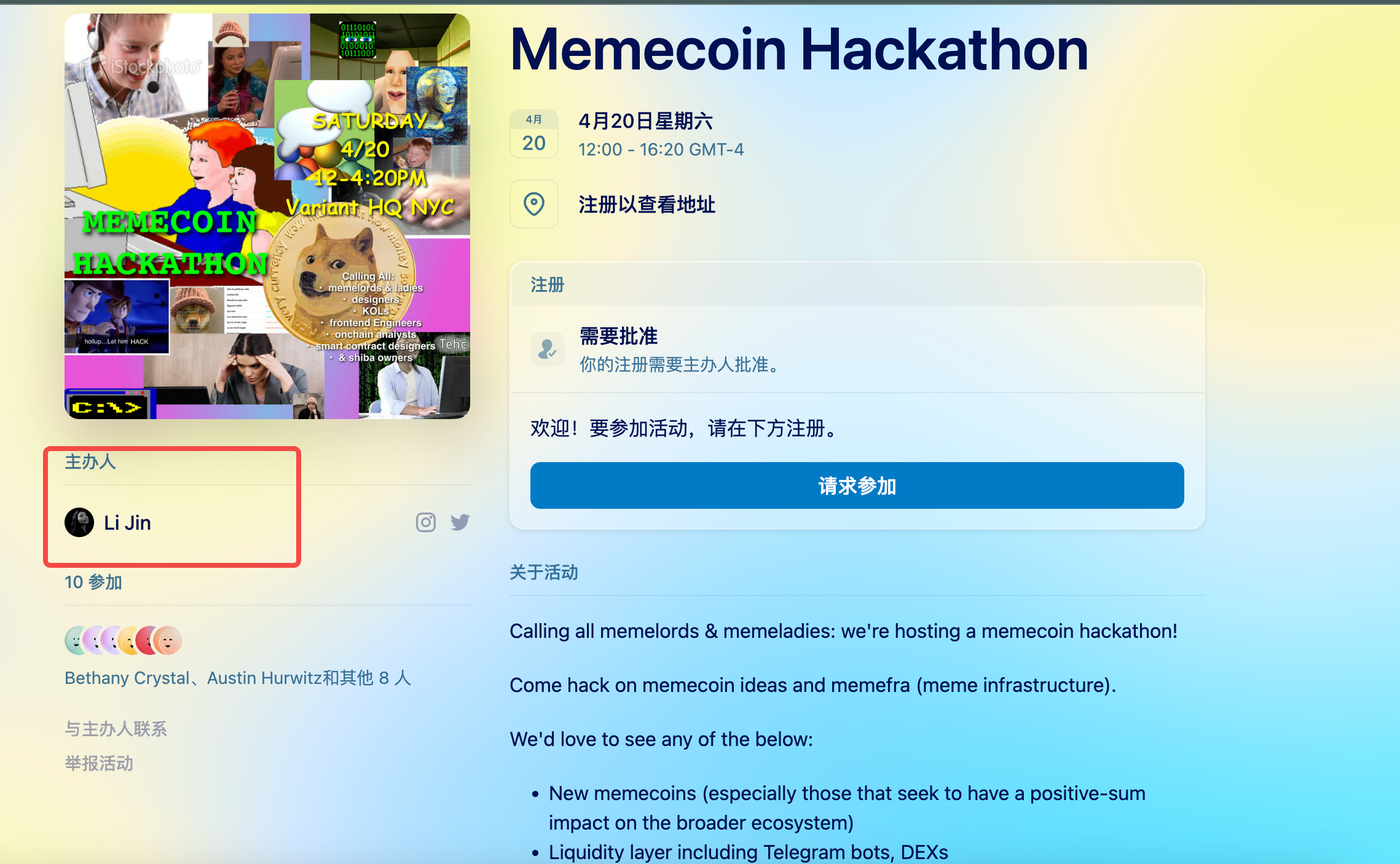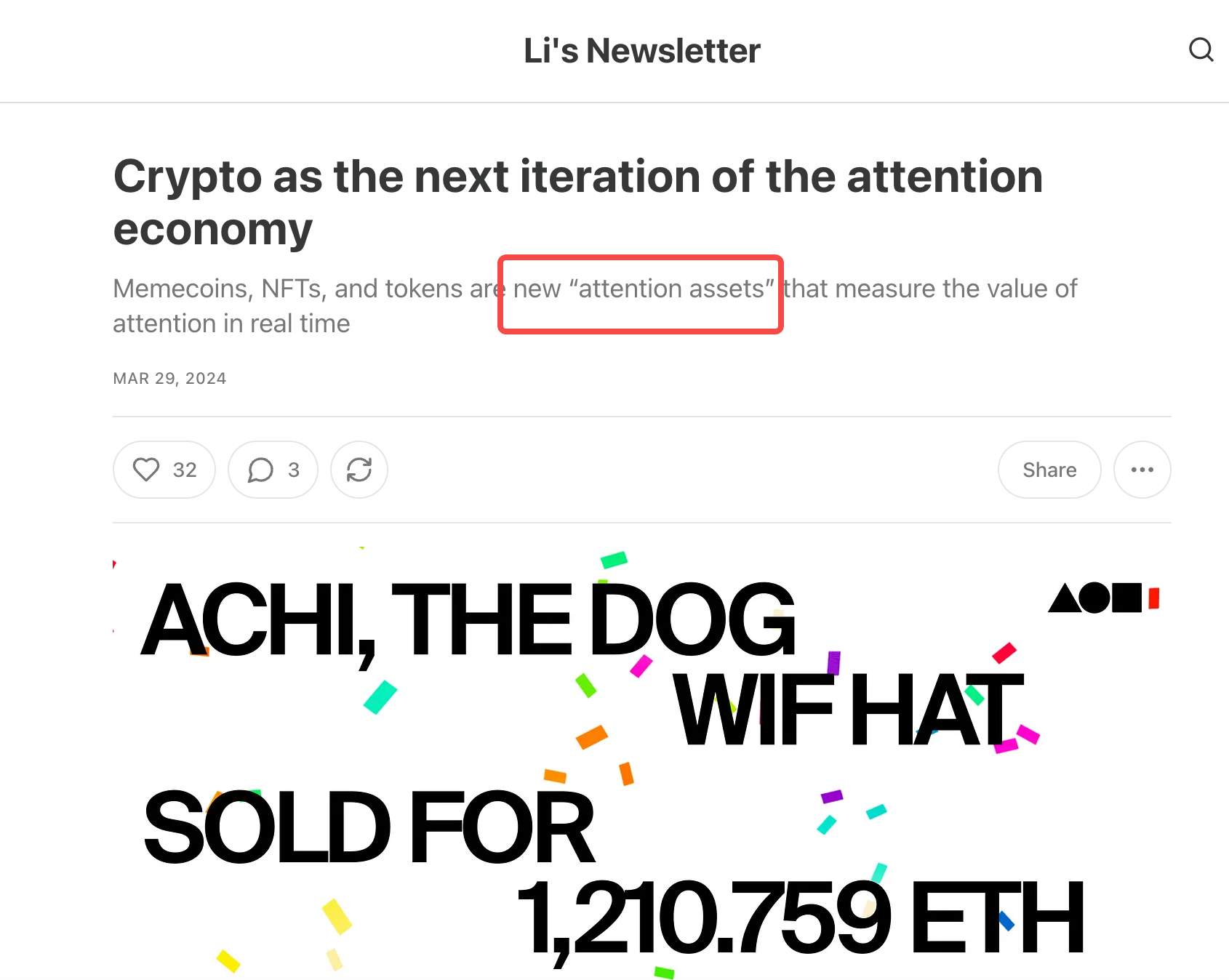Usually in the eyes of leeks, VC is a booster of the sickle, and Meme is a big red flag against the sickle.
Memes driven by culture and community often do not have too much primary investment and endorsement from big VCs. The relatively fair and random nature of the memes has gradually turned “Chong On-Chain Meme” into a carnival for leeks – you’re going to get cuts anyway, so why not try your luck in the Meme lottery?
But this carnival has not belonged to VC for a long time.
VCs with top-level foresight and vision can naturally see the change in the crypto industry. Whether it is anxiety or thinking, they have to do something to seek breakthroughs in the great wave of attention economy.
Recently, Variant co-founder Li Jin took action and wrote on his Twitter:
" Born too late to explore the Earth; born too early to explore the Universe; born at the right time to host a meme hackathon."

The event, called Memecoin Hackthon, is hosted by Li Jin on the introduction page and is scheduled to be held on April 20 at the headquarters of Variant Fund in New York. It calls on teams that can build:
- New memecoins, especially those that seek to have a positive-sum impact on the wider ecosystem
- Liquidity layer, including Telegram robots, DEX
- Applications using memecoins as a GTM strategy
- Building utility applications around memecoin
It is interesting to note that a word called " Memefra " was mentioned during the event, which means Meme infrastructure. Let teams with ideas and capabilities build Memefra. It is obvious that VCs also welcome everything that creates conditions for Meme.
Born at the right time, do VCs who have always been on the high-end infrastructure technology stream really need to start catching up with the meme wave that carries a sense of on-chain meme culture?
Attention Economy, the Perpetual Motion Machine of Crypto
In fact, VC's co-organization of the Meme Hackathon was not a whim, but more of a natural move.
VC investment focuses on value return, while Meme itself has "attention value".
In Li Jin’s earlier blog, he was keenly aware that Memecoin, NFT and tokens are new “attention assets” that can measure the value of attention in real time.

Abundant information leads to a lack of attention, so attention is a scarce resource. However, in the Web2-dominated advertising business model, the value of user attention is harvested by the platform rather than flowing to the user.
Therefore, cryptocurrency can be seen as the next iteration of the attention economy, with a more efficient market.
Memecoin can measure and capture the value of attention in real time, and users can invest and own attention assets to express their beliefs on whether a particular meme, media, creator, or network will gain more attention and interest in the future.
From this point of view, it becomes more reasonable that VCs also favor Meme coins.
After all, it is quite tempting and persuasive to successfully invest in a product that can capture the public's attention (even if it is a meme).
While attracting users’ attention, the emergence of Meme also taught many crypto projects a lesson in marketing methods and listing rhythm:
Traditionally, crypto projects follow the path of “product first, attention later” — first build a product through technology, then build a community around it through marketing, become known and grow gradually;
In the Meme Attention Economy, crypto projects can completely "attention first, product later" - by launching a project that natively integrates with the popular memecoin, new applications/infrastructure can mobilize the memecoin holder base, who can experience more utility from their tokens.
There are two different development ideas, and it is obvious that the times have chosen the latter.
No matter what kind of crypto project it is, its essence is to attract attention, get more people involved and use it, and allow more people to connect with the token.
Driven by the attention economy, the crypto has gone through many stages, from Bitcoin to Ethereum, from NFT to Meme. Each round of narrative change is a shift in attention.
Therefore, it is not surprising that VCs are focusing on making changes as needed.
Users are educated by VCs, and users also educate VCs
But you have to know that the crypto market was not dominated by the meme carnival without any origin, but followed the traditional and serious venture capital path.
When Ethereum was first born in 2014, even Vitalik had to do a project roadshow and explanation of Ethereum to various investors from the East and the West.

Although veterans in the crypto often recall that “no one understood Ethereum at the time, and now they are so disappointed that they didn’t invest in it”, even as strong as Vitalik, crypto projects have always followed the same process:
First, use your strength (or brag about your strength) to impress VCs, then go to the market and grab (or harvest) users' attention.
In this path, whether it is ICO or IEO, VCs take advantage of the early rounds to get a large number of low-priced chips, and then wait until the project moves to the secondary stage to sell them according to different unlocking conditions; among them, of course, there are savvy retail investors who want to eat meat and drink soup, but there are also a large number of people who take over the last baton.
After a long time, people get tired of it; after a round of education, users will probably understand what is going on.
Therefore, we can increasingly see projects such as Inscriptions, Runes, and Memecoin in the new cycle, which VCs rarely participate in, do not have time to participate in, or are unwilling to participate in. They have not only broken the above-mentioned inherent venture capital process, but also broken the path of attention growth:
First use explosive pull to directly attract the user's attention, and then do other things based on the user base.
Users are not afraid of sharp rises and falls, but they are afraid that I do not have a better opportunity than you to enjoy the sharp rises and falls . Obviously, Memes have given users a relatively closer channel. Even if they will be cut, it is better than being clearly taken over by VCs.
So to some extent, users are also educating VCs in turn, saying, "Sir, times have changed."
It’s interesting to see a role swap between upstream and downstream of the ecosystem, and this is what makes the crypto interesting:
Cutting and hurting each other, helping each other grow.







